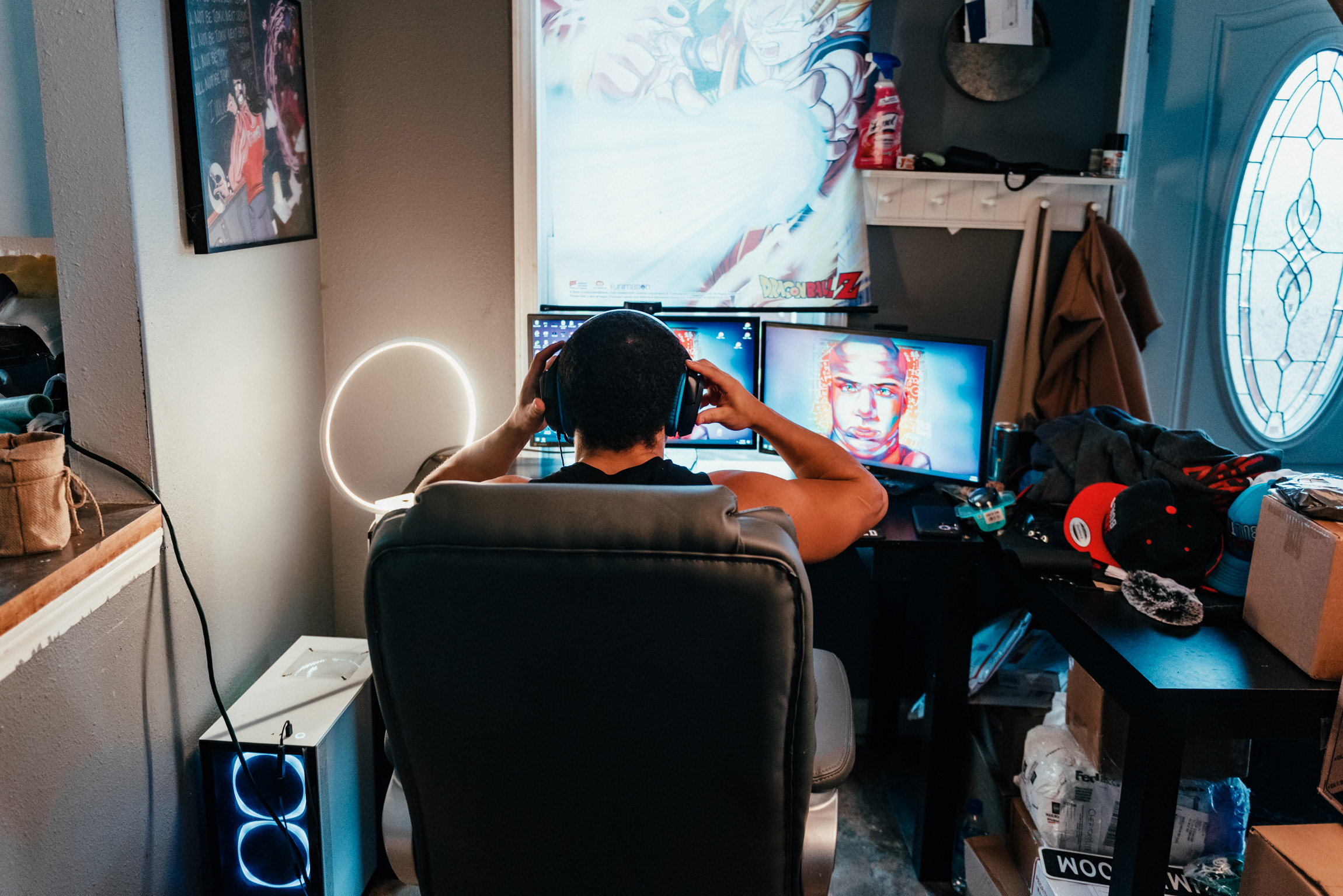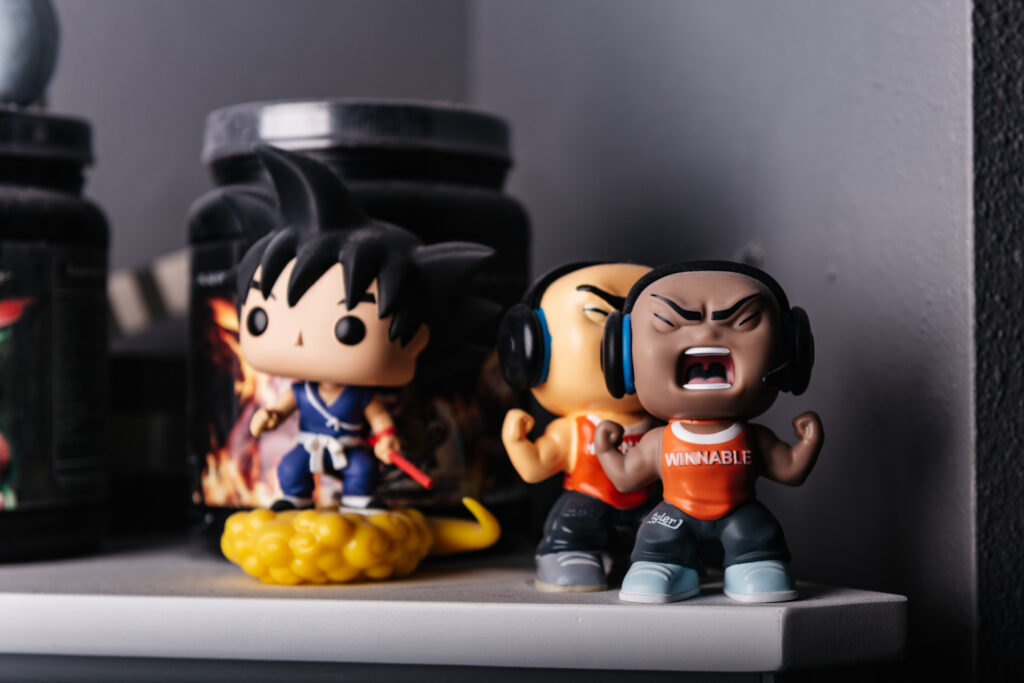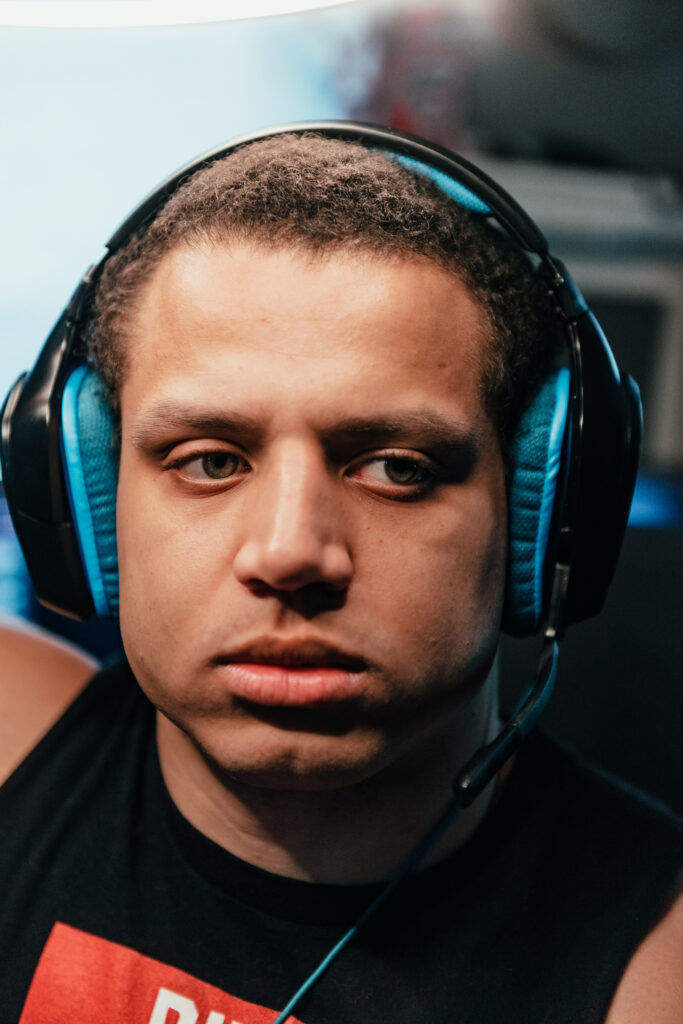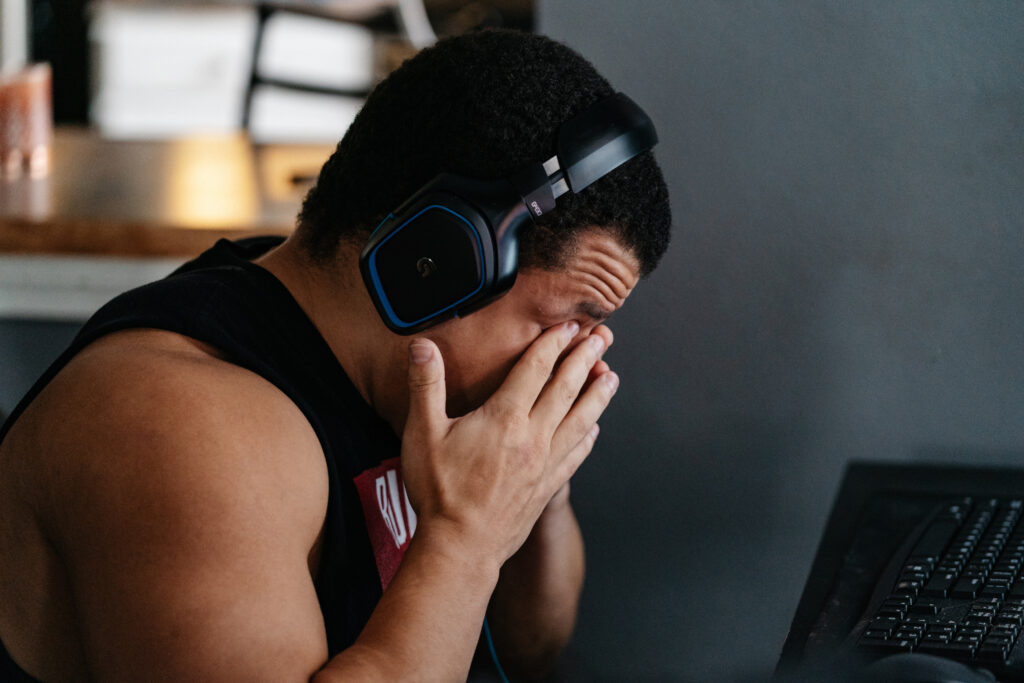Up all night with a Twitch millionaire: The loneliness and rage of an internet video game rock star from New London, Mo.

NEW LONDON, Mo. — Just before midnight, six hours into his 10-hour Twitch live stream, Tyler Steinkamp’s rage begins to erupt.
He’s just scarfed down a dinner of cold chicken fingers over the sink during a three-minute ad break and raced back to his computer, where he is playing the “battle arena” game “League of Legends” as 28,762 people watch.
His face is broadcast onto the screen, alongside convulsions of neon warfare and a raucous chat box overflowing with 280 messages a minute. An anonymous audience is demanding his attention and unloading on him for every mistake. He has four hours of on-camera time to go.
“It’s going to be a terrible day,” he tells a Washington Post reporter before turning back to his screen to read one chat message aloud: ” ‘Does “League” make y’all depressed?’ Yeah, it does.”
As “loltyler1,” his Twitch audience expects him to be tirelessly brash and dominant. But Tyler is trapped in a losing streak, and he’s been reeling from too little sleep. He dies in an in-game brawl and snaps: “I’m so over this s—.” Another 282 messages blast in.
At 26, Tyler is a millionaire and one of the internet’s most popular streamers. For 50 hours a week, he broadcasts himself playing video games from his cramped living room in his 900-person Missouri hometown to 4.6 million followers, watching from around the world.
He earns more than $200,000 a month in Twitch ads and viewer subscriptions. Sponsorships with Nike and Doritos, contracts with giant esports teams, fan donations and merchandise sales have earned him millions more.
When he dropped out of college to stream, Tyler cast himself as an alpha among dweebs, known for crude banter and wild gameplay. To a generation raised by the internet, he became bigger than a rock star: Fans pay him every month for access and intimacy, which he provides in great amounts, allowing nearly every day of his life — from his virtual battles to his most personal real-world moments — to be dissected and criticized.

Streamers like Tyler form the backbone of tech giants’ “creator economy.” With their lives on permanent display, they’ve pioneered a raw form of entertainment. While Instagram and TikTok value viral perfection, Twitch fans flock to more unpolished streamers; no one can stay perfect on a 10-hour marathon. (Twitch was bought in 2014 for nearly $1 billion by Amazon, whose founder, Jeff Bezos, owns The Washington Post.)
But the punishing need to stay relevant in a supersaturated market is also fueling severe burnout. After five years of building an unapologetically aggressive persona for an audience of mostly young men, Tyler is exhausted by the expectations of an unforgiving crowd. Tyler, whose father is Black, has endured years of personal insults and sometimes explicitly racist abuse. And as his online world has grown, his real one has shrunk dramatically. Tyler has millions of fans but no friends; before spending a recent day with a Post reporter, no one besides his girlfriend and family had visited his house in several years.
“There are just eyes on you, always on you,” he said. “Kids grew up watching me for 10 hours a day. It feels like it’s been my whole life.”
Twitch officials acknowledge that many streamers suffer from burnout and harassment. The company recently hosted a “Creator Burnout” workshop and offers mental health guides for concerns about addiction and self-harm. “We recognize that while creating content is an incredibly rewarding creative experience, a public life online comes with its own pressures and challenges,” a Twitch spokesperson said.
Tyler is one of the few to see tangible rewards from his Twitch career. When hackers in October published a vast haul of internal Twitch data, they exposed the site’s brutal economy: Though more than 7 million people stream on Twitch every month, only the top 3,000 – less than 0.1 percent – made more than the typical American household earning $67,000 a year. The vast majority earned next to nothing, streaming to empty chat rooms, waiting for a single person to come watch.
Tyler, meanwhile, has brought in more than $2.5 million from the site since August 2019, according to the leaked data, making him Twitch’s 15th highest-paid streamer around the world.

As Twitch’s viewership exploded last year — up 67 percent to more than 1 trillion minutes watched — Tyler gathered an intense fan base seeking community and escape across a fractured internet. But as a gig worker for a media empire, even a successful streamer like Tyler has a livelihood that’s inherently unstable — without insurance, unions, sick days, retirement funds or hope for a sustainable career.
Many people see popular streamers as modern-day success stories, paid only to be themselves, said Brooke Erin Duffy, an associate professor at Cornell University who interviewed influencers for her new book, “Platforms and Cultural Production.” But that “myth of glamour” obscures a reality of extraordinary pressure, she said — the grueling systems of online metrics, the incessant demands of followers, the invisible burden of personal attacks.
“These companies have tremendous power and are reaping tremendous rewards from the creator economy, but they don’t provide the mechanisms of support that a traditional workplace would,” Duffy said. “The job is profoundly individualized and precarious. The fact is, it’s all on you.”
Growing up in Missouri, Tyler loved to entertain, showing off in front of the camera at his first birthday party. When his mother, Christina Lutz, got their first computer from Rent-a-Center, the 5-year-old would stand behind her while she played Minesweeper, helping her find the bombs.
She’d had him at 17. Tyler never knew his dad, but his mom introduced him once when he was very young, worried Tyler might regret never having seen his face. In the winters, they’d heat their trailer with the oven or scrounge quarters to pay for gas.
Tyler spent hours in the school gym and in the sprawling fantasy worlds of “Diablo” and “RuneScape,” developing an all-consuming competitive streak. He’d duel into the night with his brother over video games, hugging the computer to quiet the sound.

At Central Methodist University, where he played football, he started streaming from his dorm room so his “RuneScape” buddies could watch his screen while he played. Then on Christmas 2015, his grandmother gave him a $50 Best Buy gift card, which he used to buy a webcam. His face has been on the stream ever since.
On Twitch, Tyler said, he multiplied his personality by 20: an over-the-top meathead who didn’t take himself too seriously, a stranger who joked like a friend. His teammates pounded on the door for him to come hang out, but Tyler never relented.
“I would just sit inside,” he said, “perfecting my craft.”
His audience grew until finally he made $52 in a week — enough, he reasoned, to live on, if he ate $10 worth of rice and potatoes each week. In the summer before his last year of college, he sat in his mom’s duplex and told her he’d be dropping out to stream. He would have been the family’s first to graduate. She told him it was OK, he said, “but you could see the tears.”
When he moved back home, Tyler’s mom could tell something weird was happening. She’d go to work as an elementary school secretary, making $14,000 a year, and come home to hear her son had made $700 sitting in front of a computer all day. “I could not understand why people were paying him. I still don’t,” she said.
Tyler specialized in “League,” a dazzlingly intricate game notorious for its split-second strategy. Through day-long grinds, he became one of the game’s most tactical and irritating entertainers; upset by his partners, he often killed himself to boost the enemy. When the game’s leaders banned him as a “genuine jerk” in 2016, it only boosted his bad-boy image. His numbers soared.
His fans, Tyler said, were typically guys from the United States and Western Europe looking for somewhere they could belong, a place they could share their excitement, make inside jokes and be around friends 10 hours a day. Tyler always gave people what they wanted, which was to laugh at him, so he began venturing into the absurd – cooking, singing, performing as a clown. Unbanned two years later, he returned to the game only slightly chastened, hawking a line of tank tops and phone cases labeled “REFORMED.”

His streams were free, but thousands of fans paid $5 to $25 a month to subscribe, removing ads and granting them some in-chat status symbols, like the ability to post images of Tyler’s face. Many also donated a few bucks to emblazon a message across the stream — typically some jab Tyler couldn’t ignore.
Some of it was lighthearted, slamming how he flipped pancakes during a breakfast-making stream, but Tyler shared everything, and everything could be weaponized. Viewers made fun of the shape of his head, spewed racist insults, ridiculed growing up in a trailer park, how he lived now, how he’d become “addicted” to the stream.
Tyler joked right back, but the balance was clear: The viewers knew so much about Tyler, and he knew nothing about them. And for all the hours he’d be streaming, there would be nowhere for him to hide.
Tyler wakes up that Tuesday morning in October like usual, chasing five hours of sleep with a fluorescent bottle of “Blood Rush,” a caffeinated pre-workout drink sold in a powder tub with his screaming face on the label. He has only a few hours until his stream begins.
He lives beneath a highway billboard two hours from St. Louis and rents a run-down house from his stepdad. The place is cluttered with junk: unopened boxes from fans, Tyler1 figurines. On his nightstand sit bottles of Adderall pills he’s taken for attention-deficit/hyperactivity disorder since he was in first grade.
He leaves only to lift weights at the YMCA, then comes home to his desk, with his “Dragon Ball Z” posters and a Walmart keyboard; he’s superstitious about using anything else. Around 4:45 p.m. it’s time. He starts his stream with some thumping hype music and summons a primal scream. Thousands are already waiting. “HES HERE HES HERE HES HERE,” one viewer writes, 12 seconds in.
Tyler always begins with a story spinning himself as superhuman, but on this day he also follows it with a truth: His brain is “frying” from not enough sleep. On his last stream, he’d told fans that for several years he’d been waking up in the middle of the night, gasping for air.
“Look at me,” he says with a stage laugh, flexing his biceps, lightening the mood. “If I wasn’t this big, would you be watching?”
Tyler always boasted of his focus and endurance amid a stream’s chaotic overload, his eyes darting between relentless messages as he shouted over the bruising soundscape of digital war. In the past, he’d take month-long breaks to ease his throat and rest his brain. But he is a celebrity now, and that means he has sponsorship requirements to fulfill, events to attend, corporate contracts to uphold. His latest Twitch deal includes a performance quota; he streams 200 hours a month.
He must play constantly to hold on to his top rank in each “League” season, which he typically ends with a 40-hour marathon. He allows himself to eat only during the commercial-length breaks between games, which can last 30 minutes or more. He forces himself not to yawn, because yawning means boredom. Bored viewers go somewhere else.
Some days he doesn’t have the energy to become the amped-up warrior his crowd expects. He tries to fake it, he said, but he can’t always “come alive.”
“If you take one day off, they’re like, ‘Where were you, bro? How could you?’ ” he said. “So I don’t miss days. Ever.”
When he stops streaming in the hours before sunrise, he’s often too drained to speak, peeling off his headset, rubbing his face with his palms. On off days, he rests his throat, going entire weekends without saying a word, lying in bed watching 10-minute YouTube movie recaps on his phone.
He still enjoys the thrill of competing, sparring with hecklers, captivating a crowd. But he sometimes looks in the mirror at the rings under his eyes and thinks about how blissful it must be to work in a cubicle, free to sit silently, do nothing, think.
He’s feeling more anxiety than ever and more obsessed about control, getting worked up if his headset feels off, his chair sits weird, his mouse is moved even an inch.
“How bad is it going to get?” he said. “In five years, am I going to not function if my right shoelace is tighter than my left?”
There is too much on the line to quit.
There’s his YouTube channel, where his streams are cut into clips for 2.7 million followers and a fortune in extra pay. There’s the $300,000 a year he makes from his merchandise line, run by a small team in Ohio. And there’s the onslaught of big branding deals: Tyler’s manager doesn’t consider anything under $20,000, even if it’s just a few minutes promoting something on stream.
A vast professional class of agents, coaches and brand consultants has multiplied to monetize his work. But unlike more established industries, Tyler and other streamers have few means of personal support: no producers, supervisors, mentors or human resources counselors; no one telling them to slow down.
Tyler has Ismail, his 30-year-old manager in Germany, who spoke on the condition that his last name not be mentioned due to fear of harassment. Tyler hired him as his editor, agent, booker and lead negotiator after a “hype montage” he made went viral in 2016. They’ve met only once, at a Twitch convention in San Diego in 2019.
Tyler estimates he’s made more than $5 million over the past few years, but he has no credit card, financial adviser or clear sense of how to spend it. His rare splurge this year was on a $170,000 Acura NSX sports car, which he keeps in a big tool shed.
Tyler helps fund his stepdad’s roadside fireworks stand and pays his mom $70,000 a year to bring him dinner every evening: calzones or Salisbury steak or chicken and rice. She quit her old job but still feels torn: “Is your kid supposed to take care of you and pay your income?” When people ask, she tells them she’s a personal chef, but doesn’t mention it’s for her son.
Tyler’s fans discuss his life and swap memes across Discord, Reddit and TikTok, sending him gifts like handwritten letters or a sketch of his face. But scorned followers have lashed out, demanding to know why they were ignored. One night, two fans left a note on his doorstep with their phone numbers alongside a menacing gift: a tombstone bench inscribed, “Your spirit lives within me.”
Tyler and his girlfriend, a fellow streamer named Macaiyla Edwards, have also had police officers with rifles swarm their home, forcing them to the ground, after an online harasser falsely reported they were holding a baby hostage. Such “swatting” attacks have led to multiple deaths; the couple suspects the caller wanted violence live on stream. No one has been charged. (The Ralls County Sheriff’s Office declined to comment.)
The cruelest attacks always come “from someone who watched a lot, because they know you so well,” Ismail said. “They’re watching to hate you.”
Macaiyla eats Mexican takeout on the couch that night as Tyler streams a few steps away. The two go to the gym together and try to decompress, but most nights end like this, with Tyler feverishly clicking his mouse, shouting into the screen. “I fall asleep to him screaming sometimes,” she says. He has three hours left to stream.
Raunchy and combative, Macaiyla built her own fan base, with an esports company contract and 450,000 followers across Twitch and Instagram.
But many fans come for Tyler, and have since they met on Twitch in 2016, their bickering romance playing out on stream nearly every day since. Roughly 200,000 people watched one of their dates this summer, and a popular video on Tyler’s fan subreddit shows his scowl melting after she swoops in for a kiss. “I’ve never seen him smile like that,” one fan wrote. “Imagine being happy,” another said.
Macaiyla expects to earn up to $200,000 this year, but she dreams of doing something real, like building houses or going back to work at a convenience store.

“I don’t care if I lose all my followers tomorrow. It doesn’t mean anything,” she said. “I miss people. The human interaction. Seeing the emotion in their face.”
Many of her friends have burned out, worried a day off could lose them followers to the endless scroll of streamers eager to take their place. She’s seen people stress for years over daily viewership, sliding into depression as their hopes of success fade.
She wants to get married soon, move to a big city and start a family with three to five kids. She thinks they can manage it all by slightly paring back their streaming: maybe eight hours, instead of 10.
Tyler hates change and says he’s content to stay in rural Missouri forever. He dreads leaving the house and sulked through a video-blogged vacation this summer at a Dominican resort. Living his normal life, but “not streaming, with the camera off: That would be a vacation,” he said.
Macaiyla feels guilty about the advantage she’s gained in Tyler’s shadow, but the money is too good to quit. She knows how many 20-somethings have graduated with college debt for dead-end jobs they hate.
“People out there are getting COVID to work and they barely make what I make,” she said. “Why wouldn’t I feel guilty?”
That night, she retreats to her streaming room, a windowless corner of the basement draped in fake greenery and rainbow-colored lights. Her fans revel in trashing her, and though she fights back, she is outnumbered: In less than a minute of the four-hour stream, she is called Tyler’s maid, “f—ing dumb” and told, “Imagine looking like you and demanding respect.”
She said she’s desensitized, that it’s all part of the show. But sometimes she wonders whether it’s worth sharing all those hours with people who still don’t understand her life.
“They feel entitled to know so much … and they don’t know anything,” she said. “They have this idea in their heads of what you are, and that’s just not you.”
As night slips into morning, nine hours in, Tyler accidentally hits “Stop Streaming.” He starts the next broadcast a few seconds later in a screaming fury, the camera recording him as he scrolls through his old Twitch videos, all of them 10-hours-plus, obsessed with this new 9-hour stain. “It’s like a tic,” he says, slumping in his chair, face glowing. “Just f— it, man. Maybe I just need to retire.”
He streams for another hour, then checks how viewers reacted on social media, walks to his bed and collapses. It’s 3 a.m., and the house is finally quiet.
His next stream starts in 13 hours.
Miss Clipping Out Stories to Save for Later?
Click the Purchase Story button below to order a print of this story. We will print it for you on matte photo paper to keep forever.

